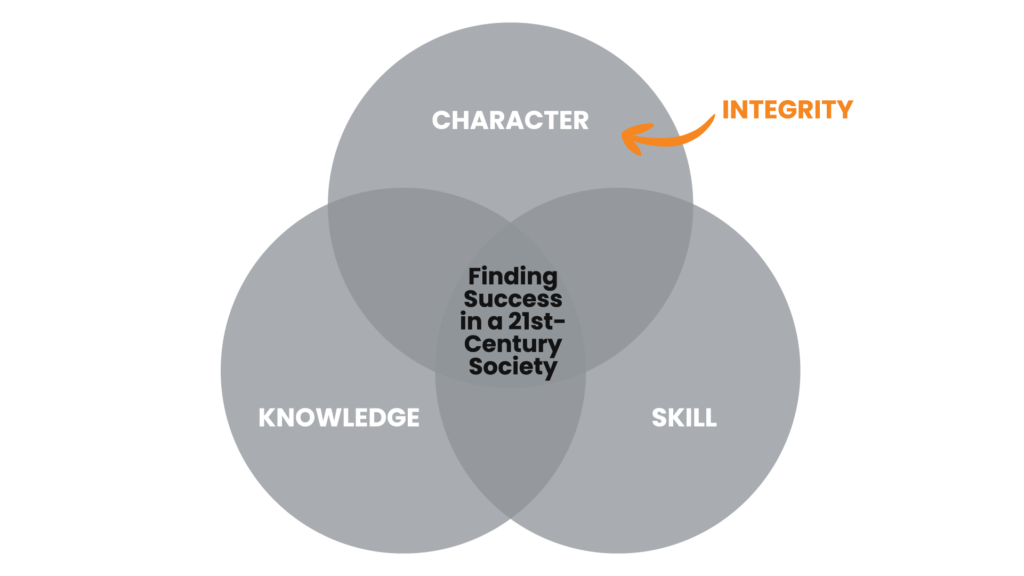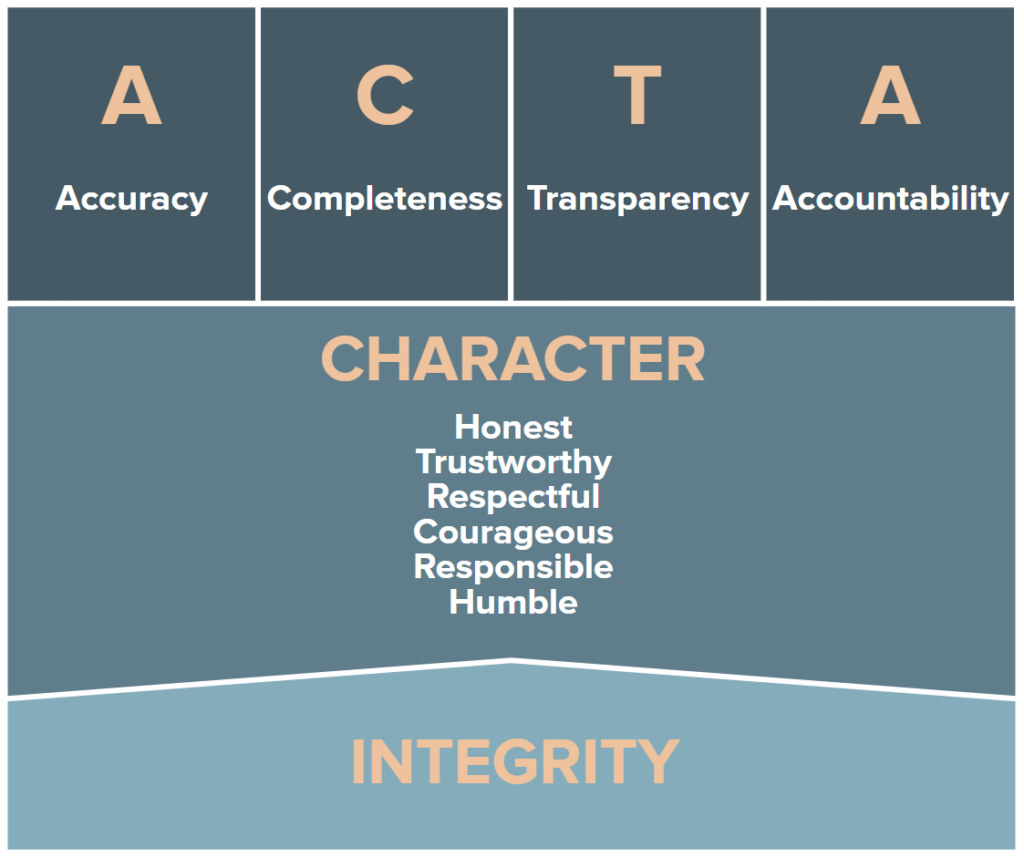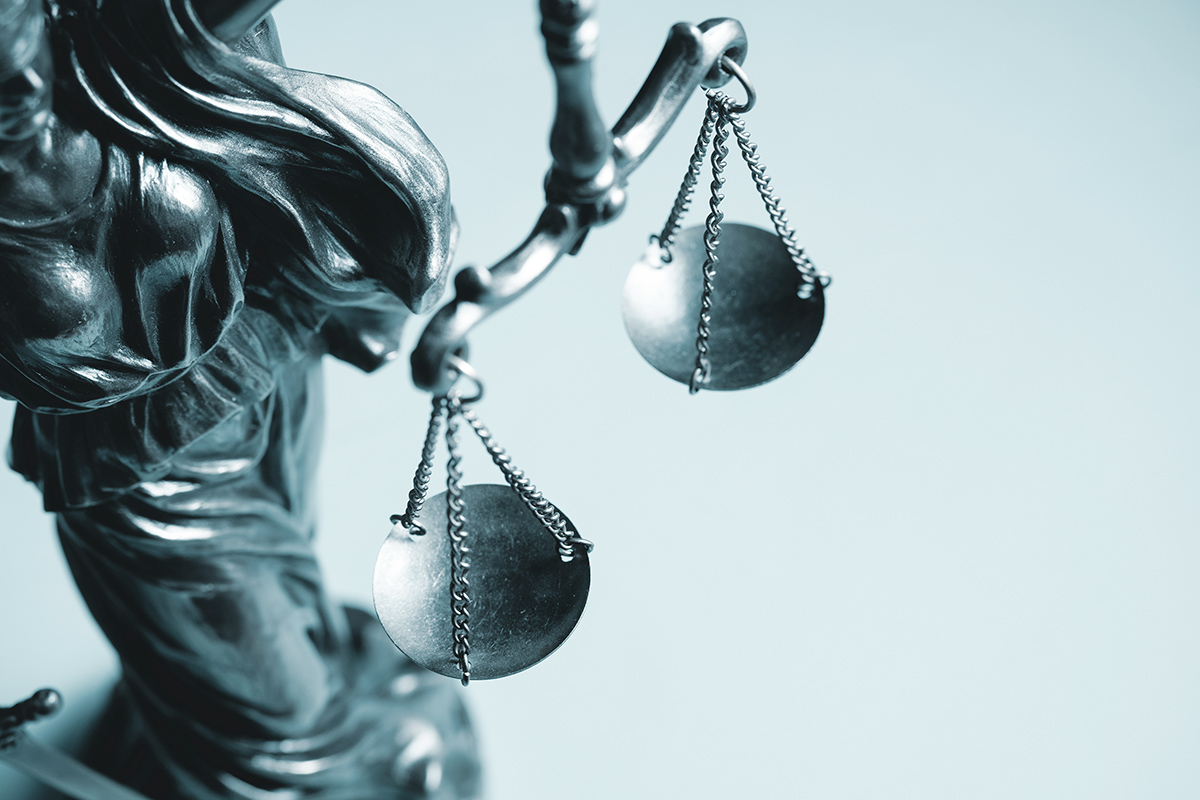ISTE Standard 7 for Coaches offers guidelines for being a digital citizen advocate through the modeling of digital citizenship and supporting students in recognizing the responsibilities and opportunities inherent in living in a digital world.
The ingredients for success in 21st-century society lie in a balance of knowledge, skill, and character. An important component of character would be ethical behavior as we conduct ourselves not just offline, but in digital environments as well. As we conduct ourselves more in online environments and leverage the use of digital tools online, it serves us well to be reminded that we leave behind digital footprints. This in turn brings to light the importance of integrity as we conduct ourselves online.

Anatomy of Integrity
In trying to understand integrity, I thought it might be interesting to first study the etymology of the word “integrity”. The root of “integrity” is “integritas” which comes from “integer” in Latin. Integrity embodies a sense of wholeness, completeness (not divided), honesty, uprightness in character, and ethical behavior. Whether in private or in public, a person of integrity exudes consistency by acting and behaving consistently. (Anderson, 2000)
We should not think of integrity simply as the soundness of moral principles and character. We ought to view integrity as an ideal, a goal to strive for. (Krulak, 2000, as cited in Weaver, 2014) For me personally, integrity is the most important personal value and ethical standard that I strive for professionally. Unlike acquiring a skill or knowledge, integrity is not something that can be achieved simply by studying. Integrity needs to be a way of life, practiced with intentionality daily.
Character of a Person of Integrity
Philippians 4:8 provides a useful guide for how one might conduct oneself to be a person of integrity.
“Finally, brothers, whatever is true, whatever is honorable, whatever is just, whatever is pure, whatever is lovely, whatever is commendable, if there is any excellence, if there is anything worthy of praise, think about these things.” (English Standard Version Bible, 2001, Phil. 4:8)
Using this verse as a guidepost, I have outlined the characteristics needed to be a person of integrity.
- Honest – a person of integrity is honest, free of deceit, is truthful, and sincere.
- Trustworthy – a person of integrity is reliable and can be trusted with the truth.
- Respectful – a person of integrity is respectful, giving due regard for the feelings, wishes, or rights of others.
- Courageous – a person of integrity also requires courage, strength, and the will to do what is right.
- Responsible – a person of integrity not only knows what is true and right but also has the obligation to act accordingly.
- Humble – a person of integrity is modest and understands surrender to a higher authority.
When conducting oneself in a digital environment, it will serve us well to use these character traits as a guide for how to behave with integrity.
Values & Principles
In carrying out an ethical audit, there are four key values and principles to look out for – accuracy, completeness, transparency, and accountability.
- Accuracy
This principle addresses the accuracy and integrity of the information we post online. In an era where fake news is becoming more and more prevalent, the need for us to verify the information we find online before posting becomes even more necessary. We ought to be cognisant that any information we post leaves a perpetuating digital footprint and becomes a reference point for someone else. Thus, we have a responsibility to verify the accuracy of the information before we put anything online. - Completeness
Possessing integrity embodies a sense of wholeness and completeness in character. This principle addresses the fact that a divided life can be a hindrance to virtuous work. Monge & Naughton (2017) posits that when one’s identity is divided into different “spheres of values”, this brings to question the genuineness and integrity of the person. The authors further propose that the “antidote to the disintegration and impurity of the divided life is the pursuit of the virtue of integrity”. Another aspect of completeness is in presenting the full picture as we share information online. Presenting one-sided stories or half-hidden truths carry with it biases that do not embody integrity. - Transparency
Digital environments and social media have made it so much easier for users to hide behind the shield of anonymity. We read about online bullies carrying out acts of oppression online by hiding behind fake digital identities. The principle of transparency here speaks of having nothing to hide, to be forthright, and to only say and do things online that we would not be ashamed of when there is the risk of exposure. - Accountability
The principle of accountability addresses the need for justifiable actions and decisions. A person of integrity should be accountable for their words and actions and ensure compliance with regulations and set standards.
Strategies for Application
In view that digital integrity transcends beyond just the soundness of moral principles and character, thus should be viewed instead as an ideal to strive for, it will take more than just instituting a set of rules to adhere to. Strategies for encouraging integrity to become a way of life therefore can be viewed across 4 pillars – governance, education, curriculum, and culture.
- Governance
The moral compass of every person may vary, hence it helps to have clearly defined boundaries and guidelines set forth and along with it, appropriate measures for governance. Good governance provides a way for measuring online conduct and to keep us accountable. Schools might consider weaving integrity into their core values. - Education
Once standards and guidelines have been set, it is important to ensure that the guidelines are disseminated and training is given so everyone is clear of the standards. For example, if integrity and associated values are set as part of the school’s values, there should be a systematic way of letting everyone know that this principle is highly regarded and to be taken seriously. - Curriculum
Punitive measures alone may not be sufficient to ensure that integrity is practiced. A more effective method is in a rethink of the educational curriculum. Miller (2019) suggests that we ought to consider teaching children about integrity at a much earlier age than is currently practiced. Along with the ethics of integrity, we should also consider including digital literacy and life skills. As Miller (2019) puts it, “We need to move from ‘how to stop them’ to ‘how to teach them’”. - Culture
Finally, to turn integrity into something we become, integrity needs to be embedded deep into the culture of the organization itself. At the heart of culture is people – it is people who make up the culture of an organization. In doing this, the leadership of the organization bears a big responsibility to model a culture of trust and integrity by walking the talk. How the organization deals with instances of dishonesty can also be turned into a teaching moment to cement a culture of integrity in the organization. By preferring grace and mercy over public shaming, students will grow up understanding grace and be compelled to always do the right thing, even when no one is looking as opposed to only doing the right thing when someone is looking, for fear of punitive action.

References
- ISTE. (n.d.). ISTE standards for coaches. Retrieved April 11, 2021, from https://www.iste.org/standards/for-coaches
- Anderson, K. (2000, May 27). Integrity – a Christian virtue. Retrieved April 11, 2021, from https://probe.org/integrity/
- Whelchel, H. (2018, April 09). Are transparency and integrity the same thing? Retrieved April 11, 2021, from https://tifwe.org/transparency-integrity-not-same-thing/
- Weaver, P. (2014, April 12). The origins of integrity. Retrieved April 11, 2021, from https://mosaicprojects.wordpress.com/2014/01/13/the-origins-of-integrity/
- English Standard Version Bible. (2001). ESV Online. https://esv.literalword.com/
- Monge, R., & Naughton, M. (2017). The divided life: A serious challenge to Virtuous work. International Handbooks in Business Ethics, 929-937. doi:10.1007/978-94-007-6510-8_48
- Miller, L. (2019, July 12). Digital integrity as a 21st Century Skill. Retrieved April 11, 2021, from https://techandcurr2019.pressbooks.com/chapter/digital-integrity/


Hello Mun, I really enjoyed reading your entry! I see you take integrity as a broad term with the intention of applying it to daily lives. In strategies of application part, did you mean application in education or in general? Sorry to ask, I just wanted to figure that out as you also have a sub title for education.
I liked the way you organized your ideas.
Thanks for sharing. As I was reading your post, there were many instances that if we were talking face to face, I would say, “I agree” or “Totally” or “I’m with you.” I love that you included Scripture. To me, integrity cannot be discussed without alluding to how God wants us to be like him in character. Our pursuit of integrity should be founded on knowing the character of God and how He wants us to live like His people.
I really like how you brought in the etymology of the word integrity. When we understand integrity as wholeness or completeness, why would we not want to strive for integrity? Living in a world that is broken and laden with sin, the pursuit of integrity helps us deal with the brokenness around us.
Thanks for sharing your comprehensive thought. I learned a lot from your post regarding values, principles, and application of the digital integrity framework. This framework is essential for educators to comprehend and implement integrity in 21st-century society, mainly digital education. By having a comprehensive understanding, I believe the implementation will be well applied in the respective context.